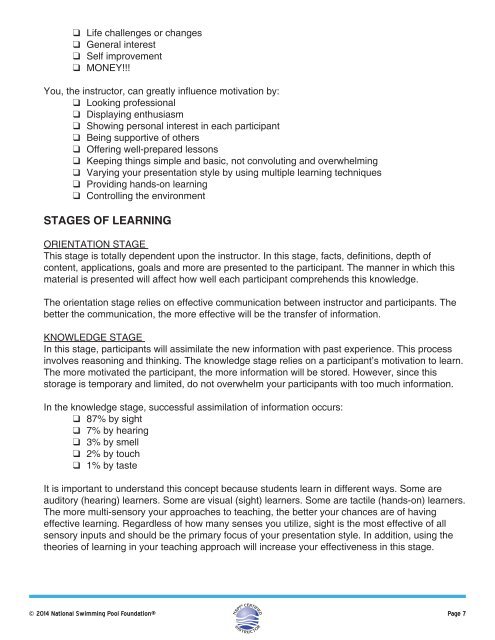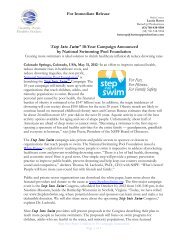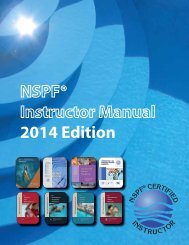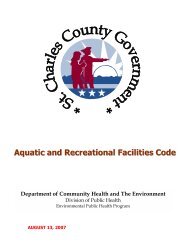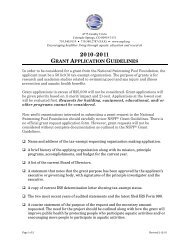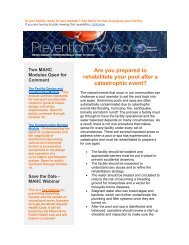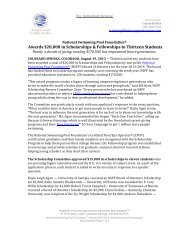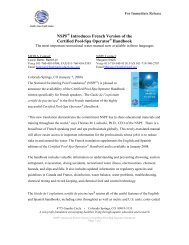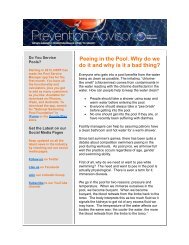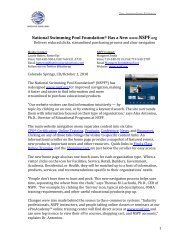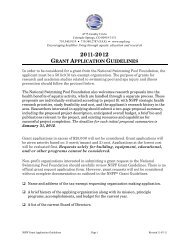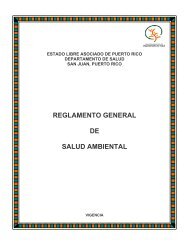- Page 1: 719.540.9119 (Phone) * 719.540.2787
- Page 4 and 5: FULL CPO ® CERTIFICATION COURSE SC
- Page 6 and 7: DISCLAIMER The information furnishe
- Page 8 and 9: CPO ® CERTIFICATION BLENDED COURSE
- Page 10 and 11: Page 4 © 2014 National Swimming Po
- Page 14 and 15: APPLICATION STAGE In this stage, th
- Page 16 and 17: Take deep breaths Use pauses Soli
- Page 18 and 19: answers. Do some post-course resear
- Page 20 and 21: Lesson Objectives are the basic goa
- Page 22 and 23: to follow all National Swimming Poo
- Page 24 and 25: Page 18 © 2014 National Swimming P
- Page 26 and 27: Page 20 © 2014 National Swimming P
- Page 28 and 29: Some areas to consider are: Traini
- Page 30 and 31: ENDORSEMENTS National Swimming Pool
- Page 32 and 33: REGISTRATION PROCESS The registrati
- Page 34 and 35: Maintain a positive approach to the
- Page 36 and 37: 5. PERSONAL RECORDS For legal and l
- Page 38 and 39: Full CPO® Certification Course Out
- Page 40 and 41: Page 34 © 2014 National Swimming P
- Page 42 and 43: Pool Operator Fusion Course Outline
- Page 44 and 45: Key Points: Explain the CPO ® cert
- Page 46 and 47: Key Point: Discuss the factors that
- Page 48 and 49: Page 42 © 2014 National Swimming P
- Page 50 and 51: American Red Cross Consumer Produc
- Page 52 and 53: industry “standard of care” in
- Page 54 and 55: pool, we must know how many square
- Page 56 and 57: Key Points: Discuss the fecal relat
- Page 58 and 59: Page 52 © 2014 National Swimming P
- Page 60 and 61: Key Points: Explain that chlorine i
- Page 62 and 63:
Page 56 © 2014 National Swimming P
- Page 64 and 65:
Key Points: Discuss the elements of
- Page 66 and 67:
Final Questions: Ask the participan
- Page 68 and 69:
PRODUCT LABEL CHEMICAL DOSAGE Amoun
- Page 70 and 71:
Final Questions: Ask the participan
- Page 72 and 73:
Key Points: Discuss the various met
- Page 74 and 75:
Page 68 © 2014 National Swimming P
- Page 76 and 77:
Key Point: Discuss the consideratio
- Page 78 and 79:
Swimming pools = 6 hours Spas = 30
- Page 80 and 81:
Key Points: Discuss the various asp
- Page 82 and 83:
Key Points: Discuss the relationshi
- Page 84 and 85:
Page 78 © 2014 National Swimming P
- Page 86 and 87:
Briefl y discuss the three advantag
- Page 88 and 89:
Key Points: Discuss the safety conc
- Page 90 and 91:
Key Points: Discuss the guidelines
- Page 92 and 93:
Have adequate safety equipment acce
- Page 94 and 95:
Page 88 © 2014 National Swimming P
- Page 96 and 97:
Key Points: Briefl y explain that c
- Page 98 and 99:
Tagging and labeling Applicable re
- Page 100 and 101:
Key Points: For troubleshooting fi
- Page 102 and 103:
Safety considerations Key Points: D
- Page 104 and 105:
Key Points: Review the local codes
- Page 106 and 107:
Final Questions: Ask the participan
- Page 108 and 109:
Page 102 © 2014 National Swimming
- Page 110 and 111:
COURSE PREPARATION The Aquatic Play
- Page 112 and 113:
3. CERTIFICATION FEES A certifi cat
- Page 114 and 115:
Page 108 © 2014 National Swimming
- Page 116 and 117:
Turnover rate Patron safety consid
- Page 118 and 119:
Turnover rate Factors that infl ue
- Page 120 and 121:
Safety concern when water levels ar
- Page 122 and 123:
Temperature and humidity concerns
- Page 124 and 125:
Severe injury at attraction Appare
- Page 126 and 127:
Key Points: Public Information (Man
- Page 128 and 129:
Key Points: Compare your emergency
- Page 130 and 131:
Page 124 © 2014 National Swimming
- Page 132 and 133:
3. CERTIFICATION FEES A certifi cat
- Page 134 and 135:
It is within the prerogative of the
- Page 136 and 137:
Page 130 © 2014 National Swimming
- Page 138 and 139:
Page 132 © 2014 National Swimming
- Page 140 and 141:
Page 134 © 2014 National Swimming
- Page 142 and 143:
Page 136 © 2014 National Swimming
- Page 144 and 145:
Page 138 © 2014 National Swimming
- Page 146 and 147:
Page 140 © 2014 National Swimming
- Page 148 and 149:
Page 142 © 2014 National Swimming
- Page 150 and 151:
Locker rooms Pool deck area Clear
- Page 152 and 153:
Activity: Hand out copies of the Fa
- Page 154 and 155:
How to control chemically induced R
- Page 156 and 157:
Key Points: Practical Application o
- Page 158 and 159:
Key Points: Describe fungi (p. 12).
- Page 160 and 161:
Mycobacterium avium complex Endoto
- Page 162 and 163:
Key Points: Provide the following i
- Page 164 and 165:
Incubation period Chronology of eve
- Page 166 and 167:
Key Points: Explain the role of org
- Page 168 and 169:
Key Points: What is verruca plantar
- Page 170 and 171:
Key Points: Discuss the ways to con
- Page 172 and 173:
Key Points: Discuss the various typ
- Page 174 and 175:
Page 168 © 2014 National Swimming
- Page 176 and 177:
TRAINING SCHEDULE The CPI course sh
- Page 178 and 179:
National Swimming Pool Foundation
- Page 180 and 181:
Lesson 5 (45 minutes) Types of spa
- Page 182 and 183:
Key Points: Discuss the need for an
- Page 184 and 185:
Key Points: Discuss the process for
- Page 186 and 187:
Gas feeders Points to consider whe
- Page 188 and 189:
Key Points: Explain the various typ
- Page 190 and 191:
Key Points: Defi ne RWIs and how th
- Page 192 and 193:
Page 186 © 2014 National Swimming
- Page 194 and 195:
Key Points: Explain the items inclu
- Page 196 and 197:
Questions: Ask the participants if
- Page 198 and 199:
Page 192 © 2014 National Swimming
- Page 200 and 201:
APPENDIX A NSPF Instructor Web Site
- Page 202 and 203:
APPENDIX B CPO® Certification Cour
- Page 204 and 205:
APPENDIX C On-Site Checklist (cont
- Page 206 and 207:
APPENDIX E Sample Pool Operator Pri
- Page 208 and 209:
APPENDIX G Sample Letter - Registra
- Page 210 and 211:
APPENDIX I Sample Letter - Repeat C
- Page 212 and 213:
APPENDIX K Water Quality Guidelines
- Page 214 and 215:
APPENDIX M Saturation Index Workshe
- Page 216 and 217:
APPENDIX O Water Chemistry Adjustme
- Page 218 and 219:
APPENDIX Q Calculations Homework 1.
- Page 220 and 221:
APPENDIX R NSPF CPO® Certification
- Page 222 and 223:
APPENDIX S CPO® Certification Cour
- Page 224 and 225:
APPENDIX T General Course Record (c
- Page 226 and 227:
APPENDIX V Pool and Spa Safety Act
- Page 228 and 229:
APPENDIX W On-Site Lifeguard Operat
- Page 230 and 231:
APPENDIX X Individual Lifeguard Ski
- Page 232 and 233:
APPENDIX Y Facility Audit Form Audi
- Page 234 and 235:
APPENDIX Y Facility Audit Form (con
- Page 236 and 237:
APPENDIX Y Facility Audit Form (con
- Page 238 and 239:
APPENDIX Y Facility Audit Form (con
- Page 240 and 241:
APPENDIX Z Accessing Online Trainin
- Page 242 and 243:
APPENDIX BB Swimming Pool/Spa Barri
- Page 244 and 245:
APPENDIX CC Electrical Safety Audit
- Page 246 and 247:
APPENDIX DD Course Business Models
- Page 248 and 249:
APPENDIX DD Course Business Models
- Page 250 and 251:
APPENDIX EE 2013-2014 NSPF Instruct
- Page 252:
APPENDIX EE 2013-2014 NSPF Instruct


